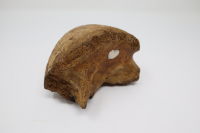Tooth - Straight-tusked Elephant
Object
Fossil
Object number
1991.381
Physical Description
Fossil, partial backend fragment of the right lower molar (M2) of Straight-tusked Elephant. Found on Evering Road, next to Rectory Road station, during sewer works in 1960.
Object history
This tooth fragment was discovered 20ft below the ground during tunnelling operations during September and October 1960 for the construction of the new Evering Road sewer. It was found about 20ft below ground, between Maury Road and the railway bridge.
Reports state that the animal remains found at the site included:
- six complete molar teeth (it is not clear if this includes this tooth which is broken) of a Straight Tusked elephant
- the front section of a Jaw of a Straight Tusked elephant
- parts of a skull (see 1991.382) of a Straight Tusked elephant
- fragments of vertebrae of the Straight Tusked elephant
- a rhino atlas vertebra (see Natural History Museum M85344),
- the leg bone 'of a rhino' (potential misidentification of 1991.1033?)
- a metatarsal/ foot bone of a Steppe Bison or Auroch (see 1991.1032)
- the tooth of a wild horse, now in the British Museum.
The finds were made by workmen, and reported to the British Museum by Mr Howard Lewis, an amateur geologist who lived nearby and who made regular visits to the excavation in order to record the deposits exposed there.
This tooth would have come from an elephant about 25 years old.
Documents related to the discovery are held by the Natural History Museum, Ref. DF PAL/129/5/4/156. Identification made by Prof. Adrian Lister.
Reports state that the animal remains found at the site included:
- six complete molar teeth (it is not clear if this includes this tooth which is broken) of a Straight Tusked elephant
- the front section of a Jaw of a Straight Tusked elephant
- parts of a skull (see 1991.382) of a Straight Tusked elephant
- fragments of vertebrae of the Straight Tusked elephant
- a rhino atlas vertebra (see Natural History Museum M85344),
- the leg bone 'of a rhino' (potential misidentification of 1991.1033?)
- a metatarsal/ foot bone of a Steppe Bison or Auroch (see 1991.1032)
- the tooth of a wild horse, now in the British Museum.
The finds were made by workmen, and reported to the British Museum by Mr Howard Lewis, an amateur geologist who lived nearby and who made regular visits to the excavation in order to record the deposits exposed there.
This tooth would have come from an elephant about 25 years old.
Documents related to the discovery are held by the Natural History Museum, Ref. DF PAL/129/5/4/156. Identification made by Prof. Adrian Lister.
Dimension
Width: 150mm
Height: 80mm
Height: 80mm
Exhibition Label
From ‘Hackney 300,000 BC: Meet the Neanderthal neighbours and curious creatures of the borough's Old Stone Age’
Straight-tusked Elephant
(600,000 - 115,000 years ago)
Straight-tusked elephants may have been the largest land mammal to have ever existed. They could weigh over 14 tonnes and reach up to 4.5 metres tall, making today’s modern elephants seem small in comparison.
In addition to their huge tusks, they are known for the distinctive ‘headband-like’ ridge sticking out of their forehead. The straight-tusked elephant became extinct in Britain about 115,000 years ago.
These huge teeth and skull fragment were found on Evering Road, next to Rectory Road station, during sewer works in 1960.
Straight-tusked Elephant
(600,000 - 115,000 years ago)
Straight-tusked elephants may have been the largest land mammal to have ever existed. They could weigh over 14 tonnes and reach up to 4.5 metres tall, making today’s modern elephants seem small in comparison.
In addition to their huge tusks, they are known for the distinctive ‘headband-like’ ridge sticking out of their forehead. The straight-tusked elephant became extinct in Britain about 115,000 years ago.
These huge teeth and skull fragment were found on Evering Road, next to Rectory Road station, during sewer works in 1960.
On display?
No




